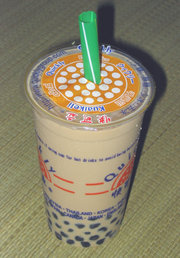Bubble tea
|
|
Bubble tea, pearl milk tea (Chinese: 珍珠奶茶; pinyin: zhēnzhū nǎichá), or boba milk tea (波霸奶茶; bōbà nǎichá) is a tea beverage mixture with milk. Originating in Taiwan, it is especially popular in Taiwan, China, Korea, the Philippines, and among overseas Asians, especially overseas Chinese. It is also known as black pearl tea or tapioca tea.
| Contents |
Definition
Bubble tea consists of a mixture of sweetened iced tea and milk and possibly other flavorings. Black gummy balls made of tapioca, called "pearls", sit at the bottom of the cup. The pearls are much larger than those found in tapioca pudding, with a diameter of at least 7 millimeters. They are sucked through a wide straw along with the drink, providing something to chew on between sips. Smaller tapioca balls can be used, but they are not as good for chewing. The tapioca balls can be fired very effectively from the large straws that are used for Boba by blowing.
When ordering, customers are often asked whether they want "boba" or "pearls" in their beverages. Both terms refer to the tapioca balls.
The recipes for bubble tea vary, but usually flavoring is added to hot black or green tea which is then shaken in a cocktail shaker with ice until chilled. The mixture is then usually combined with milk and softened tapioca pearls.
Tapioca pearls are primarily made from tapioca starch from the cassava plant. The pearls are then heated with caramel into a thick paste. The paste is then passed through a wet sieve to create different pearl sizes.
Another alternative to traditional bubble tea is to substitute tapioca pearls with coconut jelly, which is a lighter option. Coconut jelly is served in small Lego-like pieces and have a sweet, crunchy consistency. They add a new dimension to bubble tea and are often ordered "half and half" meaning half pearls, half coconut jelly.
The tea often accompanies fried chicken steak (雞排; jī pái), also a popular snack in Taiwan.
Origin
Bubble tea is said to have originated in Taichung, Taiwan in 1983, by a Taiwanese tea shop owner named Liu Han-Chieh (劉漢介), who experimented with cold milk tea by adding fruit, syrup, candied yams and, finally, tapioca balls. Although the drink was not popular at first, publicity from a Japanese television show made businessmen take notice, and it quickly became well known throughout Asia in the 1990s.
In the late 1990s, bubble tea began to become popular in the United States and Canada, spreading to ethnic Chinese, Korean, and Vietnamese-speaking immigrant communities and even outside the overseas Asian community. This unique beverage has also received some attention in the American mainstream media, including Morning Edition on National Public Radio and the Los Angeles Times. Bubble tea can also refer to hot Hong Kong-style milk tea (港式奶茶; pinyin: gǎngshì nǎichá; Cantonese: gong2 sik1 naai5 caa4) with tapioca balls.
Names
Bubble tea has now spread internationally, mainly through overseas Chinese communities. It is also known under a number of other names, including:
- bubble tea
- pearl tea
- milk pearl tea
- pearl ice tea
- black pearl ice tea
- QQ drinks — kiú is Taiwanese slang for chewy
- 奶茶 naicha — literally, "milk tea"
- 珍珠奶茶 zhēnzhū nǎichá (Putonghua, Taiwanese and overseas Chinese usage) — literally, "pearl milk tea"
- 波霸奶茶 bōbà nǎichá
- boba drink
- tran chau (Vietnamese)
- pearl sago [milk] tea — in English only; usually used for canned varieties where pearl sago (西米; xīmǐ; Cantonese: sai1 mai5) is used instead of tapioca.
Boba is Cantonese slang and literally means "dominatrix of breasts", connoting the image of a busty woman. "Bō" (波) is a slang for the breast which refers to the milk.
In southern Taiwan, pearl milk tea with large pearls are usually called "boba milk tea", while those with small pearls are called "pearl milk tea".
Availability
The tea, regardless of name, is available at small dedicated boba cafes, and at some Chinese and Vietnamese restaurants. Some Chinese restaurants and take-out delis may advertise a "boba special" promotion — for example, one cup of boba tea might cost only 99 cents with a purchase of a meal. Bubble tea chain stores are spreading throughout the world, but there are also many small family-owned boba outlets. The quality of the preparation and resulting product varies widely. Like Starbucks, boba tea is generally popular among college students.
Most bubble tea stores serve a variety of drinks, including coffee, juices, and frozen juice drinks. These can include flavors which are less familiar to non-Asians, such as taro, honeydew, or lychee—as well as the familiar chocolate, Ovaltine, or strawberry—and may be available with or without tapioca pearls. These boba establishments are typically modern, trendy and sleek in design; often, they are combined with Internet cafés in order to attract a young customer base.
Trivia
In September 2004, defending a US$18 billion weapon purchase plan, the ROC Ministry of National Defense used bubble tea as an example of the overall cost of the proposed purchase. The Ministry stated that the total cost of the weapons systems would be equivalent to the money saved if all Taiwanese drank one less pearl milk tea per week for a period of twenty years.
Related topic
Bubble tea stores
External link
- Free Boba & Bubble Tea Recipes (http://www.bubbletearecipe.com/)
- News article from CNN (http://www.cnn.com/2000/FOOD/news/11/27/bubble.tea.ap/)
- The Tale of "The Bubble Tea Origin" (http://www.jorbins.com/food-drink-magazine/articles/bubble-tea-origin.php)
- Claremont Courier Online - Bubbly drinks help teens have a ball (http://www.claremont-courier.com/mt/archives/000374.html)
- Picture of Bubble Tea (http://vagrantly.com/04/06/bubble_tea.php)
- US Bubble tea cafe locator (http://www.bobafind.com/)
- MSNBC - Can drinking less tea defend a nation? (http://www.msnbc.msn.com/id/6063203/)
- NBC - Taiwanese urged to cut tea to pay for US arms (http://www.abc.net.au/news/newsitems/200409/s1204428.htm)
- Boba Fate - bubble tea fortune-tellers (http://fortune.bedope.com/boba.html)ja:タピオカティー

